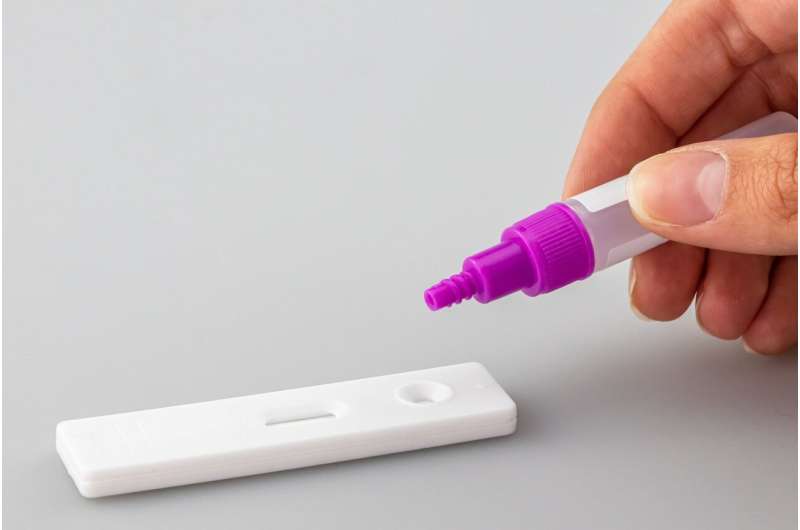
Credit: Pixabay/CC0 Public Domain
New machine learning research led by George Mason University’s Professor Farrokh Alemi and Professor Janusz Wojtusiak provides a way for patients and clinicians to better predict whether symptoms are due to COVID-19, influenza, or RSV.
A more accurate diagnosis leads to better decisions on course of care to heal patients and prevent the disease from spreading. With fellow George Mason University researchers and Vibrent Health, Alemi and Wojtusiak recently published a series of articles in a special edition of the Journal of Quality Management in Healthcare discussing how artificial intelligence (AI) can help in the diagnosis of COVID from a combination of symptoms and home tests.
With their research, Alemi and Wojtusiak are now working on a website to deliver an AI-based resource to assist individuals in identifying recommended actions as a result of their clinical profile and COVID at-home test results.
“We see AI working to radically improve clinical triage and test-to-treat decisions,” said Wojtusiak.
Alemi added, “AI will allow individuals to feel more confident about their decisions to stay home, seek care, or to socially isolate. Lots of people test at end of their symptoms and surprisingly they find they are still positive. What does one do if symptoms and home test results do not agree? Our AI will help these individuals understand how to proceed.”
The study in paper 1 (as listed below) found that the timing of symptoms matters in a COVID diagnosis. For example, a runny nose as an early symptom increased the odds of testing positive for COVID, and a runny nose as a symptom that occurred later decreased the odds. Similarly, fever is almost always a late symptom, so lack of fever early on should not be used to rule out COVID.
The results in paper 2 found that COVID cannot be diagnosed from individual symptoms; however, a cluster of three or more symptoms can aid in diagnosis. Findings from paper 4 found the accuracy of diagnosing COVID symptoms was highest when symptoms from different body symptoms were present. For example, a combination of neurological and common respiratory symptoms was more diagnostic than either one of the sets of symptoms individually. In addition, COVID has different presentations depending on age, severity of illness, and virus mutations.
Paper 3 discusses how an AI symptom screening could improve—and for vaccinated individuals replace—at-home antigen tests. At-home tests are not always accurate and require clinical review, but these tests are done at home where no such review is available. AI symptom screening can help make these tests more accurate. The study reports that AI symptom screening is more accurate than taking a second home test.
The four papers published in the special supplement are:
Order of Occurrence of COVID-19 SymptomsThe Role of Symptom Clusters in Triage of COVID-19 PatientsCombined Symptom Screening and At-Home Tests for COVID-19Guidelines for Triage of COVID-19 Patients Presenting with Multisystemic Symptoms
A fifth paper, titled Modeling the Probability of COVID-19 Based on Symptom Screening and Prevalence of Influenza and Influenza-Like Illnesses, from same group of researchers was also published in the Journal of Quality Management in Healthcare in April/June 2022.
Alemi was Mason’s principal investigator. Mason was a subcontractor to Vibrent Health, where Praduman Jain was the principal investigator of the project. (Jain is a member of Mason’s College of Public Health advisory board.) Other Mason-affiliated researchers on these projects include Associate Professor Amira Roess, affiliate faculty member Jee Vang, doctoral student Elina Guralnik, and former student and adjunct faculty Wejdan Bagais. Rachele Peterson and Josh Schilling from Vibrent Health and F. Gerard Moeller from Virginia Commonwealth University were also part of the research team.
The methods used in these five papers vary. In paper 4, researchers conducted a meta-analysis of the literature, using data from published papers. In the other papers, researchers surveyed patients who took a PCR test and examined the relationship between the patients’ symptoms and PCR test results. Most research was done using data collected between October 2020 and January 2021, prior to the current variants such as BA.5 or BQ.1.
Previous, related publications by these investigators include a study examining how computers can distinguish between COVID-19 and flu and an analysis of symptomatic university students and social distancing.
More information:
Paper 1: Janusz Wojtusiak et al, Order of Occurrence of COVID-19 Symptoms, Quality Management in Health Care (2022). DOI: 10.1097/QMH.0000000000000397
Paper 2: Janusz Wojtusiak et al, The Role of Symptom Clusters in Triage of COVID-19 Patients, Quality Management in Health Care (2022). DOI: 10.1097/QMH.0000000000000399
Paper 3: Farrokh Alemi et al, Combined Symptom Screening and At-Home Tests for COVID-19, Quality Management in Health Care (2022). DOI: 10.1097/QMH.0000000000000404
Paper 4: Farrokh Alemi et al, Guidelines for Triage of COVID-19 Patients Presenting With Multisystemic Symptoms, Quality Management in Health Care (2022). DOI: 10.1097/QMH.0000000000000398
Provided by
George Mason University
Citation:
Artificial intelligence can help patients interpret home tests for COVID-19 (2023, January 30)
retrieved 30 January 2023
from https://medicalxpress.com/news/2023-01-artificial-intelligence-patients-home-covid-.html
This document is subject to copyright. Apart from any fair dealing for the purpose of private study or research, no
part may be reproduced without the written permission. The content is provided for information purposes only.
Source: https://news.google.com/__i/rss/rd/articles/CBMiWGh0dHBzOi8vbWVkaWNhbHhwcmVzcy5jb20vbmV3cy8yMDIzLTAxLWFydGlmaWNpYWwtaW50ZWxsaWdlbmNlLXBhdGllbnRzLWhvbWUtY292aWQtLmh0bWzSAVdodHRwczovL21lZGljYWx4cHJlc3MuY29tL25ld3MvMjAyMy0wMS1hcnRpZmljaWFsLWludGVsbGlnZW5jZS1wYXRpZW50cy1ob21lLWNvdmlkLS5hbXA?oc=5